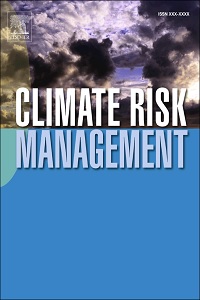Cambio climático
AGROVOC URI:
Malaria and large dams in sub-Saharan Africa: future impacts in a changing climate
Background: Sub-Saharan Africa (SSA) has embarked on a new era of dam building to improve food security and promote economic development. Nonetheless, the future impacts of dams on malaria transmission are poorly understood and seldom investigated in the context of climate and demographic change.
Reducing deforestation and enhancing sustainability in commodity supply chains: interactions between governance interventions and cattle certification in Brazil
A large number of governance interventions are being developed in order to reduce deforestation and enhance the sustainability of commodity
supply chains across the tropics. The extent to which individual agricultural commodity supply chain interventions can achieve scale, and
environmental or social objectives, depends in part on the ways in which those interventions interact with other interventions. We use a casestudy
of the new Sustainable Agriculture Network (SAN) cattle certification program in Brazil to explore the different ways in which governance
Remote sensing monitoring of land restoration interventions in semi-arid environments with a before–after control-impact statistical design
Restoration interventions to combat land degradation are carried out in arid and semi-arid areas to improve vegetation cover and land productivity. Evaluating the success of an intervention over time is challenging due to various constraints (e.g. difficult-to-access areas, lack of long-term records) and the lack of standardised and affordable methodologies. We propose a semi-automatic methodology that uses remote sensing data to provide a rapid, standardised and objective assessment of the biophysical impact, in terms of vegetation cover, of restoration interventions.
Smallholder farmers’ attitudes and determinants of adaptation to climate risks in East Africa
Adapting to climate risks is central to the goal of increasing food security and enhancing resilience of farming systems in East Africa. We examined farmers’ attitudes and assessed determinants of adaptation using data from a random sample of 500 households in Borana, Ethiopia, Nyando, Kenya, Hoima Uganda, and Lushoto, Tanzania. Adaptation was measured using a livelihood-based index that assigned weights to different individual strategies based on their marginal contributions to a household’s livelihood.
Surface organic carbon enrichment to explain greater CO2 emissions from short-term no-tilled soils.
The impact of agricultural practices on CO2 emissions from soils needs to be understood and quantified to enhance ecosystem functions, especially the ability of soils to sequester atmospheric carbon (C), while enhancing food and biomass production. The objective of this study was to assess CO2 emissions in the soil surface following tillage abandonment and to investigate some of the underlying soil physical, chemical and biological controls.
The impact of investment in smallholder irrigation schemes on irrigation expansion and crop productivity in Malawi
Reliance on rainfall for agriculture and increased climate change and variability pose growing production risks in developing countries. Agriculture in Sub-Saharan Africa is dominated by smallholder farmers who depend mainly on rain-fed agriculture, putting food security at both household and national levels at risk, especially in the event of drought. Investment in smallholder irrigation becomes a priority in developing countries if food security and national development goals are to be met, as their economies are agro-based.
The potential role of neglected and underutilised crop species as future crops under water scarce conditions in sub-Saharan Africa.
Modern agricultural systems that promote cultivation of a very limited number of crop species have relegated indigenous crops to the status of neglected and underutilised crop species (NUCS). The complex interactions of water scarcity associated with climate change and variability in sub-Saharan Africa (SSA), and population pressure require innovative strategies to address food insecurity and undernourishment. Current research efforts have identified NUCS as having potential to reduce food and nutrition insecurity, particularly for resource poor households in SSA.
Water security and climate change challenges in developing countries
When less is more: Innovations for tracking progress toward global targets
Accountability and adaptive management of recent global agreements such as the Sustainable Development Goals and Paris Climate Agreement, will in part rely on the ability to track progress toward the social and environmental targets they set. Current metrics and monitoring systems, however, are not yet up to the task. We argue that there is an imperative to consider principles of coherence (what to measure), standardization (how to measure) and decision-relevance (why to measure) when designing monitoring schemes if they are to be practical and useful.




